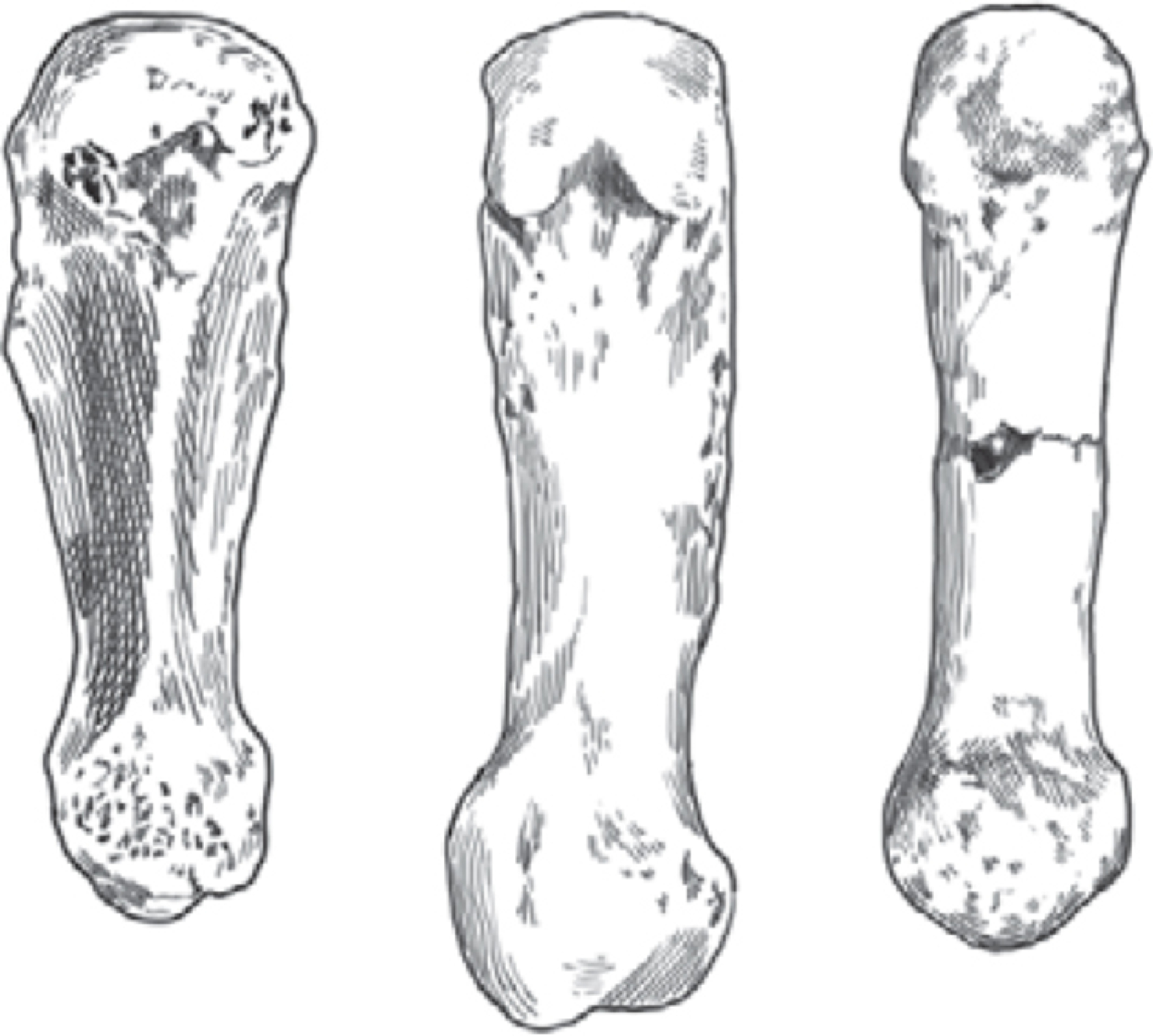22
The real work began on Monday. Marina and Becca had seen in person what the photos and video from the cave clearly showed: Bones were strewn across large parts of the Chamber floor. Several of the long bones looked hominin, they were certain. It was time to recover them. Four more archaeologists were eagerly waiting for their turn.
The morning work began with Alia and Elen descending into the cave. The first task in the Chamber itself was to clear all the bones that were on the surface. This required scanning the surface first, then collecting the elements one by one. The first bag of fossils brought to the surface that morning, to our wonder, held only hominin bones, including a beautiful right proximal femur (the top of a thighbone) and a first metacarpal (thumb bone). These were crucial finds.
The femur was similar to those found in australopiths like africanus and afarensis, with a long neck and small head. Modern human femoral necks, and those few from Homo erectus, tended to be short, stout, and rounded in cross section. This one, oval in cross section, didn’t look very human.
The first metacarpal was just as fascinating. This is the bone in the palm of the hand that connects to the base of the thumb. Peter brought it to me from the Science Tent. “I’ve never seen anything like this,” he said, holding it out in the palm of his hand.


Left to right, a first metacarpal from Rising Star, from a chimpanzee, and from Malapa’s A. sediba
I picked it up, turning it over. Neither had I. In a modern human, the first metacarpal is a small bone that looks a lot like a cartoon dog bone: a stick with two identical fatter ends. But this one was narrow at the wrist and wide where the thumb attaches. I shook my head and said, “It’s long, though.” The length of that bone in the palm of the hand reflects the length of the thumb, and a long opposable thumb was a sure sign of a hominin.
Peter nodded in agreement, though I could tell he was puzzled, too. “It doesn’t look like anything I have ever seen,” he repeated. Coming from Peter, this was saying quite a lot. Few people alive had dissected more apes and humans than Peter, who came from a long line of classical comparative anatomists in Zurich. He had also seen practically the entire hominin record in his more than 50 years in the field. If he hadn’t seen anything like this thumb bone, it truly was unusual.
I went back to the Command Center. It was time for Lindsay and Hannah to make their first trip into the Chamber. I sent a student to find them and tell them to kit up.
The next bag containing fossils that came up brought Steve Churchill from the Science Tent to the Command Center. “You’re going to want to see this,” he said with a grin.
It was another femur, also from the right side. We had a second individual! By that afternoon, a third right femur came up—yet another individual. Just this one day’s work had produced a healthy collection of around 40 individual hominin remains. Although that may not sound like many to most people, I knew this was one of the richest hauls of hominins in a single day of discovery ever. It had taken us months to collect such a number from Malapa, and Malapa had been one of the richest fossil hominin sites in history. From nearby Sterkfontein, a sum total of just over 700 individual remains had been collected, but that was from almost 70 years of nearly continuous work. The number of fossil hominin remains we had found in one day was simply unprecedented, and the mood in the camp was buoyant.
We had also found four bird bones, all lying on the surface. It appeared as if an owl had somehow got into the Chamber and died a long time ago, but long after the fossil hominin remains had been deposited there. Other than those four bones, everything that had come up so far was hominin. At the time, I attributed this just to chance. I was sure we would start to see more animal remains the next day.
That afternoon, as I was closing up the Command Center, Steven Tucker and Rick pulled me aside. They looked serious.
“What’s up?” I asked.
Steven looked at Rick, then back to me. “You know, after seeing that femur today—” he started. Rick interrupted—“we think we found another one just like it.”
I looked at them both. “Where?” I asked, presuming it was somewhere in the Chamber.
“In a completely different part of the cave system,” Rick replied. “Do you want us to go get it?”
I thought about this for a moment. I admit I was tempted. Another hominin find would be great, but I had an entire team focused on the work at hand. If indeed Rick and Steven had found another hominin site, fantastic, but we already had a dangerous job at hand. I made a snap decision.
“Don’t mention it to anyone,” I said. “I don’t want them distracted. If we finish this job, you can go after this next one.”
Both of them nodded, though I could see they were as eager as fox terriers to go fetch this bone. I grinned as I watched them walk off. More? Was that possible?